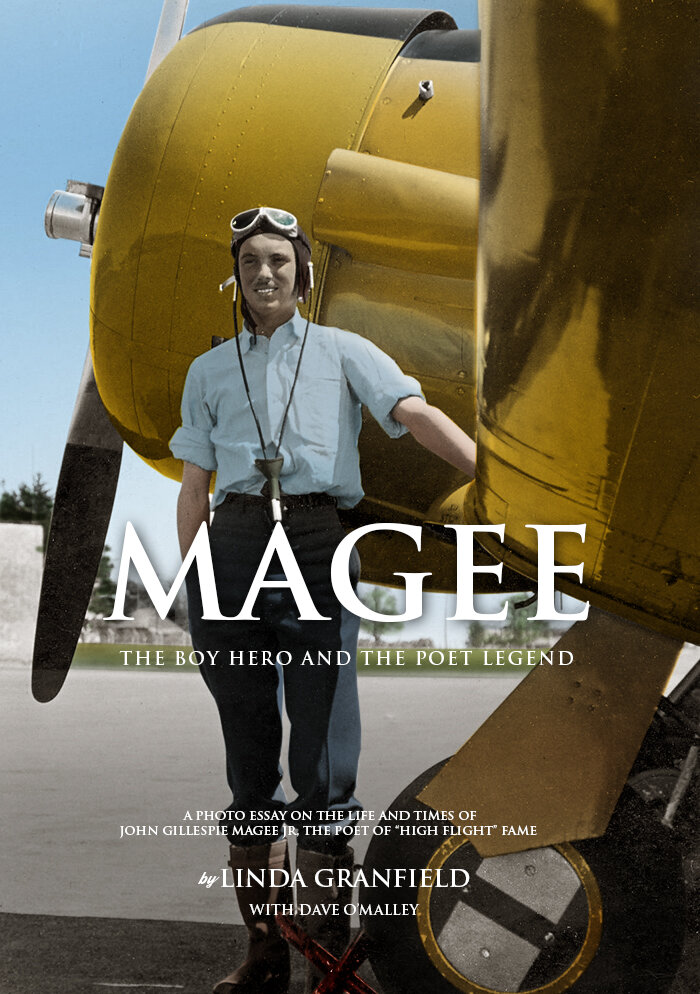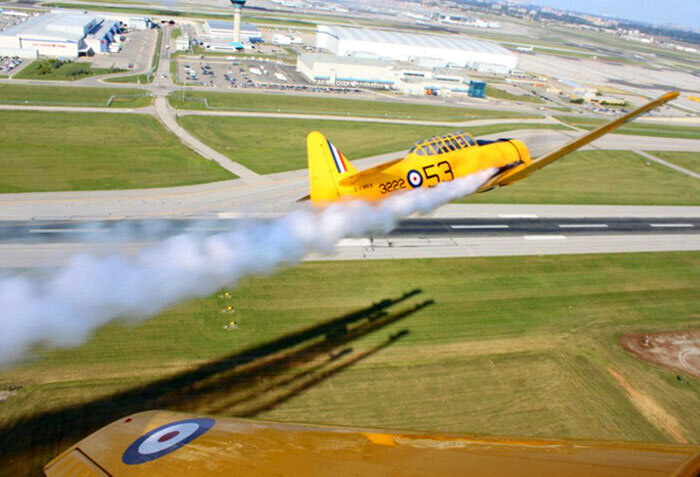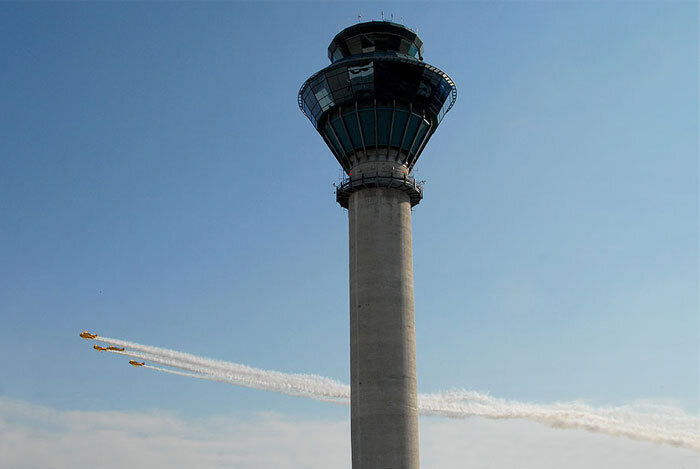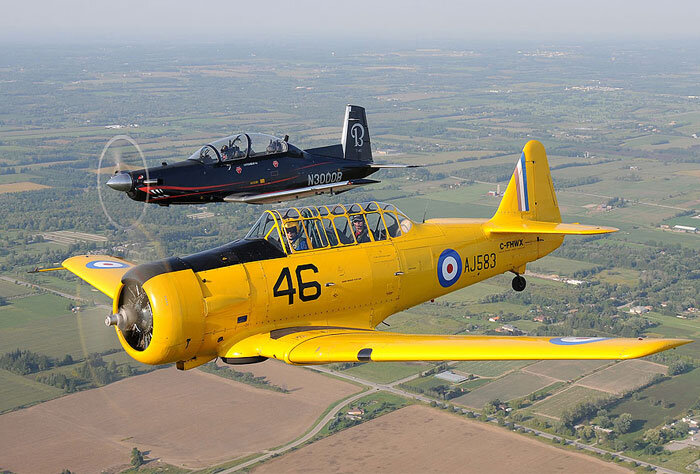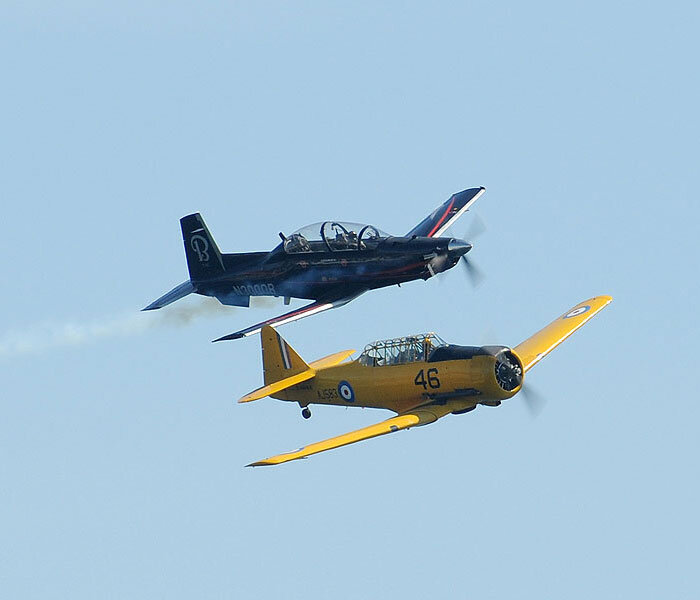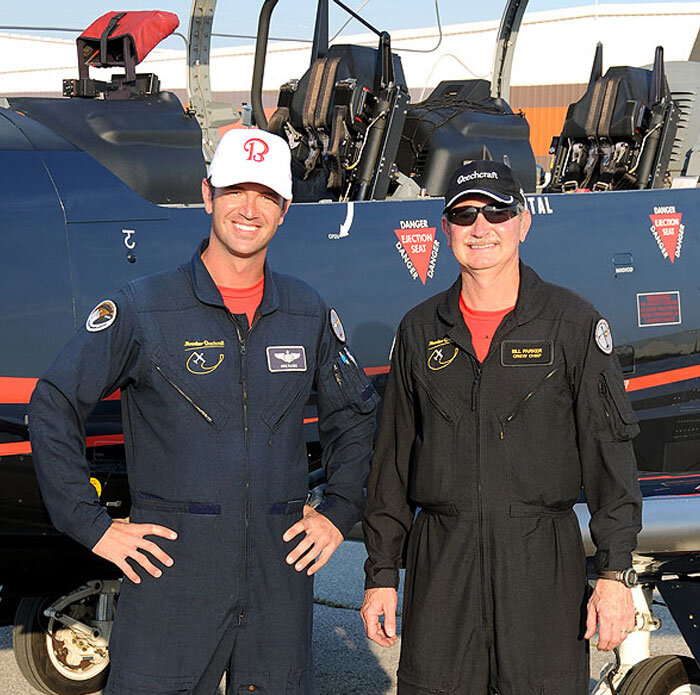HARVARD HERITAGE FLIGHT
Edward Soye is one of Vintage Wings of Canada's newest pilots. Having flown with the Canadian Harvard Aircraft Association (CHAA) for 6 years, he comes to us with plenty of experience on the type. With a broad academic background in historical studies, he is keenly aware of the cultural, social, and even global context from which the North American Harvard has emerged. When in conversation, the soft spoken aviator chooses his words well and sparingly. Here, in his elegant voice, we hear about the Harvard Heritage Flight at the Canadian International Air Show this summer and the great historic training lineage that the Beechcraft Harvard II continues today.
Over the past two years, Vintage Wings of Canada has travelled from coast to coast using the Yellow Wings program to tell the story of the British Commonwealth Air Training Plan (BCATP). In terms of scope, the BCATP was by far the most ambitious flight training program in Canadian history. That being said, the broader history of aviation in Canada is intimately linked to the training of pilots and aircrew. As early as 1915, the Curtiss Aviation School started operations at Toronto Island. As the value of air power became clear during the Great War, the Royal Flying Corps (RFC) realized the potential offered by the vast expanse of Canadian air space. The RFC set up a pilot training scheme centred in Camp Borden that grew steadily until the end of the conflict. By the end of the Great War, Canadian Aeroplanes Limited was building JN-4C “Canucks” en masse in Toronto. There were multiple satellite training airfields in Southern Ontario at places like Armour Heights, Leaside and Beamsville. The University of Toronto (Victoria College) was home to the No. 4 School of Military Aeronautics. With the end of the war, the RAF Canada scheme was wound down, but the JN-4s were sold into civilian hands where they continued to train pilots and serve in a variety of roles.
There is hardly a need to recount the particulars of the BCATP, but I will highlight a few interesting parallels between the military training schemes during both the First and Second World Wars. Both schemes were essentially built from scratch, in a short time frame, in order to train Canadian and foreign airmen. In both cases, aircraft were built in Canada on a large scale - many of which ended up in civilian hands after their lives as military trainers. In 1918, young men learned to fly in a two-seat Canuck before climbing into an Royal Aircraft Factory SE5 or a Sopwith Camel. In 1941, fighter pilots cut their teeth on the mighty Harvard before moving on to the Spitfire or Hurricane. Whether built by North American Aviation in Inglewood, Noorduyn in Montréal, or Canada Car & Foundry in Fort William (Thunder Bay), the Harvard was such a successful training aircraft that it remained in service for many decades after the end of the BCATP.
Author Edward Soye’s usual mount in the Harvard Formation Team, CHAA Harvard Mk. II , AJ 583 (C-FHWX). The Harvard Mk. II was the single-engine mainstay of BCATP Service Flying Training during the Second World War. Photo: Eric Dumigan
In the 1950s, the Harvard remained a workhorse of the RCAF. Rather than training Allied pilots to fight in the Second World War, it was used to train NATO pilots who would go on to fly Sabres and CF-100s [Also called the “Canuck” – Ed.] in the skies over Europe or in defence of North America. The Harvard, a design from the 1930s, served in the RCAF until 1965, when they were sold into civilian hands en masse. Other countries, such as South Africa, continued to use the Harvard as an active military trainer into the 1990s! From the 1960s until the early 2000s, the tradition of Canadian military flight training continued with the Beechcraft Musketeer, Slingsby Firefly, the Grob and the venerable Canadair Tutor. In the 21st century, a new version of the Harvard, built by Hawker-Beechcraft (formerly Raytheon), returned to Canadian skies as part of the NATO Flying Training in Canada scheme.
Hawker Beechcraft Texan II Demonstration pilot, Michael “Gameshow” Rambo is seen during a right-hand bank over Toronto. Photo: Eric Dumigan
As a pilot, I’m very fortunate that the majority of my flying for the past several years has been at the controls of a Harvard. I’ve flown with the Canadian Harvard Aircraft Association for 6 years and started flying the “High Flight Harvard” at Vintage Wings earlier this year. Aviation history is truly my passion and, as a regular Harvard pilot, I felt a strong desire to help commemorate the proud history of Canadian flight training outlined above. The USAF ran a successful Texan Heritage Flight program for a number of years, so I wondered why we couldn’t do the same here in Canada.
Dave Hewitt deserves credit for breaking ground in terms of a Canadian Heritage Flight program. He flew his Harvard alongside the CF-18 in a number of shows, which was both an impressive feat of flying and a unique juxtaposition of aircraft performance. Vintage Wings took up the torch of coordinating Heritage Flights with the annual Canadian Air Demonstration Formation Camp in Gatineau. Nonetheless, neither of these was the Harvard Heritage Flight that I had in mind. In 2011, the Yellow Wings team came close to my vision when the tour stopped in Moose Jaw, Saskatchewan – home of 2 Canadian Forces Flying Training School (2CFFTS). During their visit, the CF-156 Harvard II finally flew in formation with a vintage Harvard. This was a great achievement, but had limited public visibility owing to the nature of the venue. At the 2012 Canadian International Air Show (CIAS) in Toronto, it was finally possible to display the new and old Harvard in formation, before a large crowd, in an air show environment.
Related Stories
Click on image
In 2011, Vintage Wings of Canada's John Gillespie Magee Harvard 4 visited Moose Jaw, Saskatchewan as part of the Yellow Wings Western Tour. This was one of the first times a Canadian-marked Harvard from the Second World War flew with a modern Beechcraft Harvard II of Moose Jaw's “Big 2” (2CFFTS). Photo: RCAF
The CIAS deserves much credit for bringing together the assets required to make this flight possible. The show’s organizers were well aware of my desire to coordinate a Harvard Heritage flight. They put me in touch with Michael "Gameshow" Rambo, the Hawker Beechcraft demo pilot and Deputy Regional Executive - NORTHCOM Business Development. We exchanged details about our flying experience and it quickly became apparent that a Heritage Flight was well within the realm of possibility.
Mike is an ex-USAF Texan II demo pilot who had flown similar heritage flights many times before. Most recently, he flew one in New Zealand and we used the profile of that demo as the basis for our display in Toronto. I’m a FAST qualified formation pilot and my usual air show act is a 4-ship Harvard formation display. In addition to several hundred hours in formation, I’ve flown with dissimilar types ranging from Great War fighters to relatively modern machines. Based on this experience, Mike was able to secure corporate authorization for us to fly together and we were all set to make this long standing goal a reality.
Hawker Beechcraft Texan II Demonstration pilot, Michael Rambo poses on the wing of the Texan II. Mike is an ex-USAF Texan II demonstration pilot who has performed in many Heritage Flights. Photo: Eric Dumigan
We both arrived at Toronto's Pearson International Airport (CYYZ or YYZ) on the Thursday before the show. As an aside, it was rather novel to arrive at Canada’s busiest airport in a 7-plane formation of Harvards! Over the next 5 days, the controllers in the tower were treated to series of flypasts that involved no shortage of smoke, noise, or yellow airplanes. After settling into our temporary home at CYYZ, Mike and I briefed for a photo flight with Eric Dumigan, who had kindly offered to shoot the formation air to air. This article relies heavily on his photographs and, as those images illustrate, our photo mission was a complete success.
In between landing airliners, the impressive seven-ship Harvard formation arrives over YYZ after participating in the Canadian International Air Show. Photo: Eric Dumigan
Taken from Harvard # 4, CHAA Service Crew Chief Shane Clayton captures the shadow cast by the 7-ship, as we circled the tower at Pearson and gave the controllers their own private show. (Two weeks later, while sitting in the Maple Leaf Lounge on my way to help at the VWC Air Show, I realized what a spectacular view we must have given to those lucky souls who were waiting for a flight on the Sunday afternoon of Labour Day weekend). Photo: Shane Clayton
The seven plane formation leaves a pall of smoke over the Lester B. Pearson International Airport. Photo: Shane Clayton
Harvard lead, Pete Spence, leads the seven-ship Harvard formation in a 360 orbit around Toronto International Airport’s Control Tower. Photo: Bernadette Dumigan
Vintage Wings Harvard pilot Edward Soye is seen at the helm of a CHAA aircraft over a busy Toronto International Airport after taking off on runway 15L. Photo: Eric Dumigan
In terms of the air show itself, the schedule was sequenced so that the various Harvard acts flew back to back in what was informally referred to by insiders as the “Harvard Hour of Power”. The sequence started with a solo demo by Michael Rambo in the Harvard/Texan II. While Mike was on stage, demonstrating the awesome, jet-like performance of the aircraft, I launched to a hold east of the show site. Following the solo demo was the all important Heritage Flight, then a 4-ship non-aerobatic formation display, a 7-ship pass, and 3-ship formation aerobatic routine. Needless to say, the growl of the Harvard became a familiar sound around Toronto during the Labour Day weekend.
It just so happens that I live in downtown Toronto and the hold point put me at 1,500’ almost directly over my condo. After I landed from the practice on Friday, I checked my phone and was amused to see messages from several friends in the area who had heard the growl of a Harvard circling overhead at max-continuous power. A few minutes after launching to the hold, Mike called last pass in his aerobatic sequence. With a few bursts of smoke, Rambo and I quickly acquired contact with one another. The plan was for him to form up in echelon on the inside of my turn. Although I was flying at 140 kts – a good clip in the Harvard – Mike was able to close smartly at 260+ kts. He slid into position as we circled over the departure end of runway 08 at Toronto Island Airport (CYTZ). At the same time, the other 3 members of the Harvard Formation Team lined up on the runway below us. With Mike on my wing, I called the Air Boss and informed her that we were inbound for our first pass.
Ed Soye leads the Harvard Heritage Flight over the Scarborough Bluffs during the photo shoot. Michael “Gameshow” Rambo holds formation in the Hawker Beechcraft Texan II. Photo: Eric Dumigan
Photo plane pilot and Harvard Formation Lead, Greg Burnard, did a great job leading the Harvard Heritage Flight through the busy Toronto airspace. The Flight is seen in a tight orbit over Scarborough. Photo: Eric Dumigan
The Harvard Heritage Flight is seen heading back to YYZ for recovery on runway 23. Photo: Eric Dumigan
Diving in from the hold, we passed overhead the button of 08 and the Harvard 3-ship launched into the same hold we had just vacated. From there, we came around the corner of Ontario Place doing a healthy 175 kts for a photo pass at 300’. After a dog bone turn at stage right, we came back along the 500’ line in close trail/line astern - smoke on. At the end of this pass, we turned out towards the lake and did a wide turn, setting up to run in towards show center. At the 1,500’ line we did a cross over break, where Mike gently stepped up so that it looked more dramatic for the crowd than it actually did from the cockpit. From here, the Harvard II exited stage right on his way back to CYYZ and I departed stage left to join up with the 4-ship.
After joining up over the Island Airport, the new and old Harvards run in for their first pass. Photo: Sane Clayton
Edward Soye leads the Harvard Heritage Flight on the opening pass at the Canadian International Air Show. Photo: Eric Dumigan
Ed and Mike performing the crossover break. Photo: Eric Dumigan
After I joined back up on the left wing, the Harvard Formation Team performed our usual demo, with passes in Diamond, Goose, Line Astern and a final pass in Diamond. After turning away from the crowd on the last pass, The Canadian Harvard Aerobatic Team (CHAT) descended in from behind the crowd – trading height for speed – to slide in behind the 4-ship. We were now in a 7-ship arrow with stinger. The whole group came around for a single pass. According to those watching from the ground, the crowd went silent as the 7-ship approached. The front five aircraft trailed smoke for the first portion of the pass. Just beyond center stage, the call HARVARDS – SMOKE OFF – NOW signalled the front aircraft to turn off their smoke at the same moment that CHAT turned theirs on. Then the call AERO TEAM – PULL – NOW resulted in the two teams separating so that the 4-ship could return for landing and the 3-ship could climb to begin their awe inspiriting demonstration of formation aerobatics.
The Harvard Formation team comes around the corner of Ontario place on their first pass down the 500’ line. Photo: Eric Dumigan
Ed is seen setting the spacing in the #2 position as the Harvard Formation Team turns away from the crowd after the line-astern pass. Photo: Eric Dumigan
The seven-ship Harvard fly-past turns in toward centre-stage, roaring over Lake Ontario close to High Park. Photo: Eric Dumigan
The seven-ship Harvard flight at centre-stage, seconds before the Harvard Aerobatic Team break from the formation. The pass left the airspace covered in smoke that eventually settled onto the water. It was an impressive sight to see. Photo: Eric Dumigan
Our Service Crew Chief, Shane Clayton, was reviewing photos that night – in particular those taken at the moment that the 3-ship broke out of the larger formation. Shane has a keen eye for historical comparisons. He recalled a similar photo of the RCAF Goldilocks Harvard Team taken in 1963 and soon found a copy of the image online. As you can see, it bore an uncanny resemblance to the ones taken earlier that day. It was satisfying to realize that not only had the Heritage Flight highlighted the proud history of Harvards in Canada, but our 7-ship also carried on the tradition of Harvard formation flying established by the RCAF decades earlier.
The 3-ship Harvard Aerobatic Team pulls up and away from the 4-ship Harvard Formation team and creates an image reminiscent of a break performed by The Goldilocks. Photo: Eric Dumigan
The Goldilocks in 1963 performing a break that looks remarkably similar to the one at the CNE, some 60 years later. The Goldilocks team was formed of seven Harvards flown by instructor pilots performing a parody of the Golden Hawks [Hence the irreverent name- Ed] aerobatic displays which the instructors purported was their view of how their students flew. The team was disbanded when the Harvard was replaced by the Tutor. Photo: Andrew Henwood
I was immensely satisfied to finally perform a Harvard Heritage Flight at one of the largest air shows in Canada. We demonstrated that it could be performed safely and that it was a crowd pleaser (see the image below from the Toronto Star, after the first day of the show). In a perfect world, the next step would be to include an RCAF Harvard II at the next Canadian Air Display Formation Camp. Much like the Centennial of Flight Trio, the Yellow Wings Tour, or the various Fighter Heritage Flight programs, a sanctioned program could travel from coast to coast and share the proud history of Canadian Harvard pilots from the 1940s until today.
The Harvard Heritage pilots after a successful first flight together and A2A (air to air) photo shoot. Photo: Eric Dumigan
Michael poses the Texan II to show off the rugged design. Photo: Eric Dumigan
With plenty of power Michael had no problem manoeuvering around the Harvard photo ship. Photo: Eric Dumigan
Michael hanging the Texan II off our right wing during the photo shoot on the Thursday before the show. Photo: Eric Dumigan
Hawker Beechcraft’s Texan II crew, Michael Rambo and crew chief Bill Parker.
Postscript
Thanks to members like Shane Clayton, members of the Canadian Harvard Aircraft Association are keenly aware of the historic context in which their Harvards were first operated. Here we see a comic re-enactment of an earlier humorous incident with the famous Goldilocks Harvard aerobatic team – recaptured to perfection. Shane Clayton explains:
“The idea for a re-enactment of the candid Goldilocks crew photo was actually quite by chance. When the Snowbirds visited Tillsonburg at the end of August, some of our Service Crew wanted to take crew photos on a Harvard with the Snowbirds in the background. Part way through shooting I remembered a photo from the book 'Harvard! The North American Trainers in Canada' by Fletcher/MacPhail (the ultimate guide to RCAF Harvards) showing a very candid shot of the pilots of the 1962 Goldilocks formation team all stuffed into a Harvard, and thought we could do the same. It turned out quite well, but I thought we could attempt a more exact re-shoot in the future with more planning. The biggest changes would be no hats (we were all wearing our red Service Crew ball caps) and a change of aircraft since the Harvard used in the first photo had the characteristic Harvard Mk 4 antenna and ADF dome removed.
As the day was winding down after our Wings & Wheels show, we set up the tripod and went for it. The only thing we couldn't duplicate was the foot sticking out of the bottom access panel as we have the smoke oil tank mounted directly above the panel. Ironically, the aircraft we posed with (RCAF 20242/C-FWPK) was used as #2 in a 4-ship Goldilocks re-enactment air show routine from 1975-78 when she was owned by Jim Vernon.”
1962 Goldilocks Photo (L to R): Moe Campbell, Bernie McComiskey, Jerry Davidson, Murray Neilson, Mike Matthews, Bernie LaPointe and Denny Lambert
2012 CHAA Photo (L to R): Marc Thompson, Percy Contractor, Shane Clayton, Jack MacKenzie, Shawn Newman, Shawn Wylie and Jarod Smith







